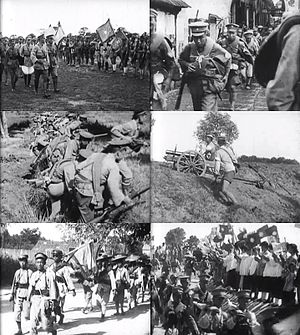
Back الحملة الشمالية Arabic Espedición del Norte AST Северен поход Bulgarian Expedició del Nord Catalan Severní pochod Czech Felttoget i Nordkina 1926-1928 Danish Nordfeldzug German Norda Ekspedicio Esperanto Expedición del Norte Spanish Põhjaekspeditsioon Estonian
| Northern Expedition | |||||||
|---|---|---|---|---|---|---|---|
| Part of the Warlord Era | |||||||
 Clockwise from top-left: Chiang inspecting soldiers of the National Revolutionary Army; NRA troops marching north; an NRA artillery unit in combat; civilians showing support for the NRA; peasants volunteering to join the expedition; NRA soldiers preparing to launch an attack. | |||||||
| |||||||
| Belligerents | |||||||
|
Supported by: | ||||||
| Commanders and leaders | |||||||
|
|
| ||||||
| Strength | |||||||
|
c. 100,000 (July 1926)[7] c. 264,000 (Dec. 1926)[8] c. 700,000 (spring 1927)[9] c. 1,000,000 (1928)[10] |
c. 700,000–1,000,000 (1926)[10][11] c. 190,000–250,000 (Dec. 1928)[1] | ||||||
| 366,000-953,000 deaths (including non-combatants) estimated[12] | |||||||
The Northern Expedition was a military campaign launched by the National Revolutionary Army (NRA) of the Kuomintang (KMT) against the Beiyang government and other regional warlords in 1926. The purpose of the campaign was to reunify China, which had become fragmented in the aftermath of the Revolution of 1911. The expedition was led by Generalissimo Chiang Kai-shek, and was divided into two phases. The first phase ended in a 1927 political split between two factions of the KMT: the right-leaning Nanjing faction, led by Chiang, and the left-leaning faction in Wuhan, led by Wang Jingwei.[13] The split was partially motivated by Chiang's Shanghai Massacre of Communists within the KMT, which marked the end of the First United Front. In an effort to mend this schism, Chiang Kai-shek stepped down as the commander of the NRA in August 1927, and went into exile in Japan.[14][15]
The second phase of the Expedition began in January 1928, when Chiang resumed command. By April 1928, the nationalist forces had advanced to the Yellow River. With the assistance of allied warlords, including Yan Xishan and Feng Yuxiang, nationalist forces secured a series of decisive victories against the Beiyang Army. As they approached Beijing, Zhang Zuolin, leader of the Manchuria-based Fengtian clique, was forced to flee, and was assassinated shortly thereafter by the Japanese. His son, Zhang Xueliang, took over as the leader of the Fengtian clique, and in December 1928, announced that Manchuria would accept the authority of the nationalist government in Nanjing. With the final piece of China under KMT control, the Northern Expedition concluded successfully and China was reunified, heralding the start of the Nanjing decade.[16]
- ^ a b Jowett 2017, p. 8.
- ^ Fenby 2004, pp. 117, 119–123.
- ^ Kotkin 2014, pp. 626–629.
- ^ Gao 2009, p. 115.
- ^ Jacobs 1981, p. 211.
- ^ Wilbur 1983, p. 14.
- ^ Jowett 2017, pp. 2, 7.
- ^ Jowett 2017, p. 7.
- ^ Jowett 2014, p. 26.
- ^ a b Jowett 2017, p. 2.
- ^ Jowett 2014, p. 35.
- ^ Rummel, R. J. (2017). "Genocide and Mass Murder Since 1900". China's Bloody Century. p. 74.
- ^ Taylor 2009, p. 68.
- ^ Taylor 2009, p. 72.
- ^ Boorman, Cheng & Krompart 1967, p. 53.
- ^ Taylor 2009, p. 83.
© MMXXIII Rich X Search. We shall prevail. All rights reserved. Rich X Search